Extract from The Guardian
Tens of thousands of Sydney protesters call for a focus on the cost
of climate change to Pacific Islands, while an unusually high turnout
marches in Canberra
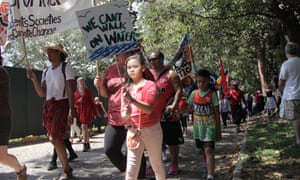

There was a strong Pacific Islander presence at the Sydney climate
protest march on Saturday, raising awareness of the devastating impact
rising sea levels on low-lying island nations.
Photograph: Ben Doherty for the Guardian
Climate change
rallies rolled on across Australia on Sunday, following well attended
protests in Melbourne on Friday and Darwin and Brisbane on Saturday.
On Sunday, it was the turn of Sydney, Canberra, Adelaide, Hobart and Perth.
Australia’s climate-sensitive neighbours in the Pacific were a key focus for the climate change rally in Sydney, with representatives of communities from Pacific nations – including Tuvalu, Nauru, Kiribati and Tonga – prominent at the front of the march from the Domain to Circular Quay.
Dressed in red, they carried signs that read: “2C too late”, “We can’t walk on water”, and “Raise your voice, not sea levels”.
Previously, Pacific leaders such as Kiribati’s Anote Tong, and PNG’s Peter O’Neill have implored Australia to be the voice of the Pacific at climate change talks in Paris beginning Monday.
More than 40,000 people braved Sydney’s heat for the rally Sunday afternoon, calling on Australia to play a lead role in brokering binding emissions targets for the world to keep global temperature rise below 2C, and to commit to greater domestic emissions cuts than the 26% to 28% the government is currently proposing.
Despite the seriousness of the subject matter, the mood of the march was rumbustious, even festive. A salsa band played Arrow’s “Hot, Hot, Hot” all the way down Macquarie Street.
Sydney’s lord mayor, Clover Moore, told the march the COP21 meeting beginning in Paris on Monday would be “the most important meeting of our life time”.
“On it depends the future of our planet,” she said.
The prime minister, Malcolm Turnbull, announced Australia would contribute $1m towards the establishment of a Commonwealth climate finance access hub, to help small island states access funds for climate mitigation and adaptation.
“These countries have asked for assistance in accessing the climate finance they need to effectively deal with climate change,” he said in a statement.
The deputy opposition leader and shadow foreign affairs minister, Tanya Plibersek, spoke to reporters before the Sydney rally and said Australia’s contribution to the fund was “pathetically puny” and failed to comprehend the scale or imminence of the Pacific’s climate problem.
“Climate change is not a distant future threat for our Pacific neighbours, it is happening right now. You are seeing storm surges washing away coastlines, you are seeing saltwater creeping into fresh water sources, you are seeing drought preventing crops growing properly, making it harder for communities to feed themselves.”
Unlike Sydney’s spirited march, it was a very peaceful, family-oriented affair in Canberra, as people brought their children to march with them from Parliament House to the tent embassy, near Old Parliament House.
Police estimate about 3,000 people showed up, while protesters think the number was closer to 6,000. Canberrans are fairly cautious about protesting, as many are public servants and are often reluctant to make political statements.
One of the coordinators of the event, Emma Robinson from the Conservation Council, said she was not surprised that so many showed up in the capital.
“Climate change is and has always been everyone’s business,” she said.
The event was staffed by about 80 volunteers, most of whom were Canberra locals and part of the Conservation Council.
Former chief scientist of Australia, Penny Sackett, said that protests like Sunday’s made people feel as though they were taking action on climate change.
“People can become discouraged because it appears as though [political] change does not happen swiftly enough,” she told Guardian Australia.
She said the march was a message from voters to world leaders who are about to meet on climate change in Paris. “We’re watching.”
The Perth event started sombrely. At 3.25pm, at least 5,000 people sat in silence in Hay Street Mall to mark people who have lost their lives, homes and livelihoods to the effects of climate change. The group, in their colour blocks, had marched 2km from Wellington Square and stretched the whole 300-metre length, watched by bemused Christmas shoppers clutching plastic bags and taking photos of the crowd.
The march was led by a group from the Noongar Whadjuk nation and addressed by Christian, Islamic, Jewish, and Hindu faith leaders.
The aim, Perth assistant bishop Tom Wilmot said, was to show unity and tell political leaders that the will of the people was for change. “We can have prosperity without growth,” Wilmot said.
Kevin Jolley, president of the firefighters union of WA, who addressed the crowd in his heavy fire gear, said WA had already seen the devastating impact of climate change in its worsening bushfire seasons.
Six people died in bushfires in November, four in fires near Esperance, WA, and two in fires in South Australia.
It’s the deadliest Australian bushfire season since 2009, when 173 people died in the Black Saturday bushfires, and, Jolly said, it was only the start of the southern fire season.
“There are no [climate] sceptics at the end of a fire hose,” Jolly said.
On Sunday, it was the turn of Sydney, Canberra, Adelaide, Hobart and Perth.
Australia’s climate-sensitive neighbours in the Pacific were a key focus for the climate change rally in Sydney, with representatives of communities from Pacific nations – including Tuvalu, Nauru, Kiribati and Tonga – prominent at the front of the march from the Domain to Circular Quay.
Dressed in red, they carried signs that read: “2C too late”, “We can’t walk on water”, and “Raise your voice, not sea levels”.
Previously, Pacific leaders such as Kiribati’s Anote Tong, and PNG’s Peter O’Neill have implored Australia to be the voice of the Pacific at climate change talks in Paris beginning Monday.
More than 40,000 people braved Sydney’s heat for the rally Sunday afternoon, calling on Australia to play a lead role in brokering binding emissions targets for the world to keep global temperature rise below 2C, and to commit to greater domestic emissions cuts than the 26% to 28% the government is currently proposing.
Despite the seriousness of the subject matter, the mood of the march was rumbustious, even festive. A salsa band played Arrow’s “Hot, Hot, Hot” all the way down Macquarie Street.
Sydney’s lord mayor, Clover Moore, told the march the COP21 meeting beginning in Paris on Monday would be “the most important meeting of our life time”.
“On it depends the future of our planet,” she said.
The prime minister, Malcolm Turnbull, announced Australia would contribute $1m towards the establishment of a Commonwealth climate finance access hub, to help small island states access funds for climate mitigation and adaptation.
“These countries have asked for assistance in accessing the climate finance they need to effectively deal with climate change,” he said in a statement.
The deputy opposition leader and shadow foreign affairs minister, Tanya Plibersek, spoke to reporters before the Sydney rally and said Australia’s contribution to the fund was “pathetically puny” and failed to comprehend the scale or imminence of the Pacific’s climate problem.
“Climate change is not a distant future threat for our Pacific neighbours, it is happening right now. You are seeing storm surges washing away coastlines, you are seeing saltwater creeping into fresh water sources, you are seeing drought preventing crops growing properly, making it harder for communities to feed themselves.”
Unlike Sydney’s spirited march, it was a very peaceful, family-oriented affair in Canberra, as people brought their children to march with them from Parliament House to the tent embassy, near Old Parliament House.
Police estimate about 3,000 people showed up, while protesters think the number was closer to 6,000. Canberrans are fairly cautious about protesting, as many are public servants and are often reluctant to make political statements.
One of the coordinators of the event, Emma Robinson from the Conservation Council, said she was not surprised that so many showed up in the capital.
“Climate change is and has always been everyone’s business,” she said.
The event was staffed by about 80 volunteers, most of whom were Canberra locals and part of the Conservation Council.
Former chief scientist of Australia, Penny Sackett, said that protests like Sunday’s made people feel as though they were taking action on climate change.
“People can become discouraged because it appears as though [political] change does not happen swiftly enough,” she told Guardian Australia.
She said the march was a message from voters to world leaders who are about to meet on climate change in Paris. “We’re watching.”
The Perth event started sombrely. At 3.25pm, at least 5,000 people sat in silence in Hay Street Mall to mark people who have lost their lives, homes and livelihoods to the effects of climate change. The group, in their colour blocks, had marched 2km from Wellington Square and stretched the whole 300-metre length, watched by bemused Christmas shoppers clutching plastic bags and taking photos of the crowd.
The march was led by a group from the Noongar Whadjuk nation and addressed by Christian, Islamic, Jewish, and Hindu faith leaders.
The aim, Perth assistant bishop Tom Wilmot said, was to show unity and tell political leaders that the will of the people was for change. “We can have prosperity without growth,” Wilmot said.
Kevin Jolley, president of the firefighters union of WA, who addressed the crowd in his heavy fire gear, said WA had already seen the devastating impact of climate change in its worsening bushfire seasons.
Six people died in bushfires in November, four in fires near Esperance, WA, and two in fires in South Australia.
It’s the deadliest Australian bushfire season since 2009, when 173 people died in the Black Saturday bushfires, and, Jolly said, it was only the start of the southern fire season.
“There are no [climate] sceptics at the end of a fire hose,” Jolly said.
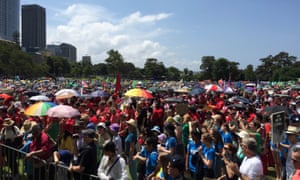
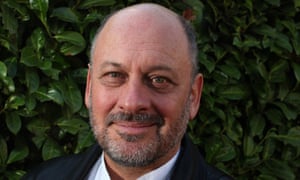

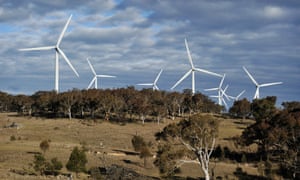


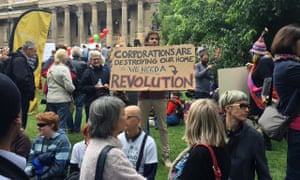

@lenoretaylor
They have gone up and down and they might not be rising by as much as if we’d never heard the words “climate change”, but in absolute terms our greenhouse emissions are trending up, not down.
And yet over those same decades we will have solemnly given three different national pledges to reduce our emissions and, as the environment minister, Greg Hunt, keeps enthusiastically reminding us, in every case we will “meet and beat” our pledges.
How can it be possible for national emissions to rise over 30 years while a country “meets and beats” successive promises to reduce them? The answer takes us first deep into the complicated and chaotic world of international climate negotiations and then to the dizzying heights of political spin.
We start in 1997 in the Japanese city of Kyoto, where John Howard’s environment minister Robert Hill held out late into the night for a special deal recognising Australia’s reliance on fossil fuel industries.
And in the end he got it. Whereas Europe promised to reduce emissions by 8% by 2012, compared with the base year of 1990, and the US agreed to cut by 7%, Australia was one of three countries allowed to increase emissions – by 8%.
But then, long past the point where most delegates were supposed to have left and many had not slept in days or were passed out on sofas or behind pot plants, Australia insisted on yet another special deal – so particular to our circumstances it was called “the Australia Clause”. It allowed the inclusion of land-use changes in emission calculations in a way that meant restrictions that had already been imposed on large-scale land clearing – especially in Queensland – allowed Australia to rest assured it had achieved its new target before it even signed up to it.
I reported on that meeting for the Australian Financial Review – the dusty boxes of files dredged from the backrooms of the parliamentary library remind of the brinkmanship Australia engaged in, still demanding the Australia Clause changes when the translators had already left the building and the cleaners had started rearranging the room for the next scheduled conference.
When it was done, the European environment spokesman raged that the deal was “wrong and immoral ... and a disgrace” and the then executive director of the Australia Institute, Clive Hamilton, quickly calculated that Australia’s emissions were likely to come in under the new target, without the need to do anything.
Hill got an ovation when he returned to cabinet and John Howard declared the deal to be “splendid”. News Ltd columnist Piers Akerman said those accolades weren’t enough, Hill should “have been greeted by massed brass bands and a 21-gun salute” because he had “saved Australia’s economy from the destructive forces of environmental activism”.
Nevertheless, the Howard government still refused to ratify the treaty, following the lead of George Bush, who by this time had replaced Bill Clinton. Ratification had to wait for the Rudd government to be elected 10 years later. It then delivered precisely the windfall that had been predicted before the ink was dry in Kyoto.
Fast forward to 2009 in the Danish capital, Copenhagen. Malcolm Turnbull had just been dumped as Liberal leader because he was determined not to lead a party as committed to climate change as he was, and domestic politics was descending into the six intellectually-arid years of “climate wars”. Nevertheless, Australia’s major parties maintained a bipartisan agreement for a next-stage target – that they should promise to cut emissions by between 5% and 25% (compared with 2000 levels) by 2020.
In the domestic political melee, the target “range” we had promised internationally shrank back down to just the absolute minimum 5% cut, which was originally the amount we were prepared to do even if other countries did nothing at all. Everyone just stopped talking about the higher targets.
By this time, I was reporting on the summit for the Australian, watching Kevin Rudd as he sat through all-night talks with world leaders, only to see the chances of a deal scuttled by China’s stone-walling. (He used the memorable phrase “rat-fucking” to describe that attitude, subsequently reported despite the briefing being off the record.) The meeting ended in chaos after even longer periods of sleeplessness than Kyoto, with then climate change minister Penny Wong looking close to collapse at a 4am press conference. But it did inscribe the various national promises into an accord, which in subsequent meetings was bolted into the UN processes.
And Australia was again able to meet the new minimum 2020 target while doing very little by way of emission-reducing policies. First, because we overshot the first +8% “21-gun salute” target, we got to “carry over” the excess to the second “commitment period”, ending in 2020. Hill’s deal in Kyoto greased the path for Rudd’s in Copenhagen.
Second, lower electricity demand thanks to manufacturing industry closures, the enthusiastic uptake of solar by Australian households, the drought and lower coal exports than expected, mean emissions have fallen without any economy-wide carbon policy.
In 2008, when Rudd was devising the emissions trading scheme, Australia thought it would have to find a way to reduce cumulative greenhouse emissions by 1,335m tonnes by 2020 to get to minus-5%. That forecast has been steadily revised down and this week Hunt announced it was now nothing at all.
This is mainly due to things outside government control. But other factors include: the impact of the renewable energy target and the government’s Direct Action policy; 22m tonnes of free abatement we received in the form of international permits from landfill operators, who ended up with a windfall gain after the abolition of the emissions trading scheme; and 128m tonnes of “carryover” we are counting. Under the accounting rules that means we are indeed already on track to meet our minus-5% target, even though private sector forecasts (the official ones have not been released yet) say actual emissions will rise by 4%.
Hunt described the idea that we should consider actual emissions as “one of the oddest and strangest and I’ve got to say ... desperate arguments” he had heard, and pointed out that the accounting rules had been accepted internationally and by successive Australian governments. Which is true. But when most people hear that Australia is meeting an emissions reduction target, they probably get the impression that our actual emissions are, you know, being reduced.
Now fast forward to the Paris meeting next week, attended by Turnbull on Monday, when all 130 leaders in attendance will give a short statement in two simultaneous speed-speaking sessions. (Turnbull is sandwiched between the leaders of Equatorial Guinea and Norway). Hunt will also be there for the first week and the foreign minister, Julie Bishop, for the second.
Australia is promising to reduce emissions by between 26% and 28% by 2030, based on 2005 levels. The “based on 2005 levels” bit is important, because that calculates our percentage reduction from the highest base year. It’s a lacklustre but not ridiculously low goal when compared with other developed economies.
The aim of Paris is to build a system to review and rachet up these volunteered national commitments, and Australia is playing a constructive role in those negotiations.
Australia is not the only country to have tried to use international rules to its domestic advantage. But Australia’s history of special deals now raises some big domestic policy questions.
First, since the 5% target for 2020 is clearly a doddle, and since the rest of the world is clearly acting, why don’t we take on a higher 2020 target, as we promised?
Second, the factors that have been pushing our emissions down are unwinding. Land clearing is increasing, we are generating more electricity from the dirtiest brown coal since the carbon price repeal and big LNG projects are coming on stream that will also push up our greenhouse gases. Neither major party has yet detailed policies that could turn that around.
And third, the accounting rules may not come to our rescue another time. It is not clear whether we will be able to “carry over” again, although Hunt has indicated we would like to. But the task is now also bigger than any “carry over” could massage.
After decades of fighting and fudging, Australia will have to really do something about its greenhouse emissions this time.